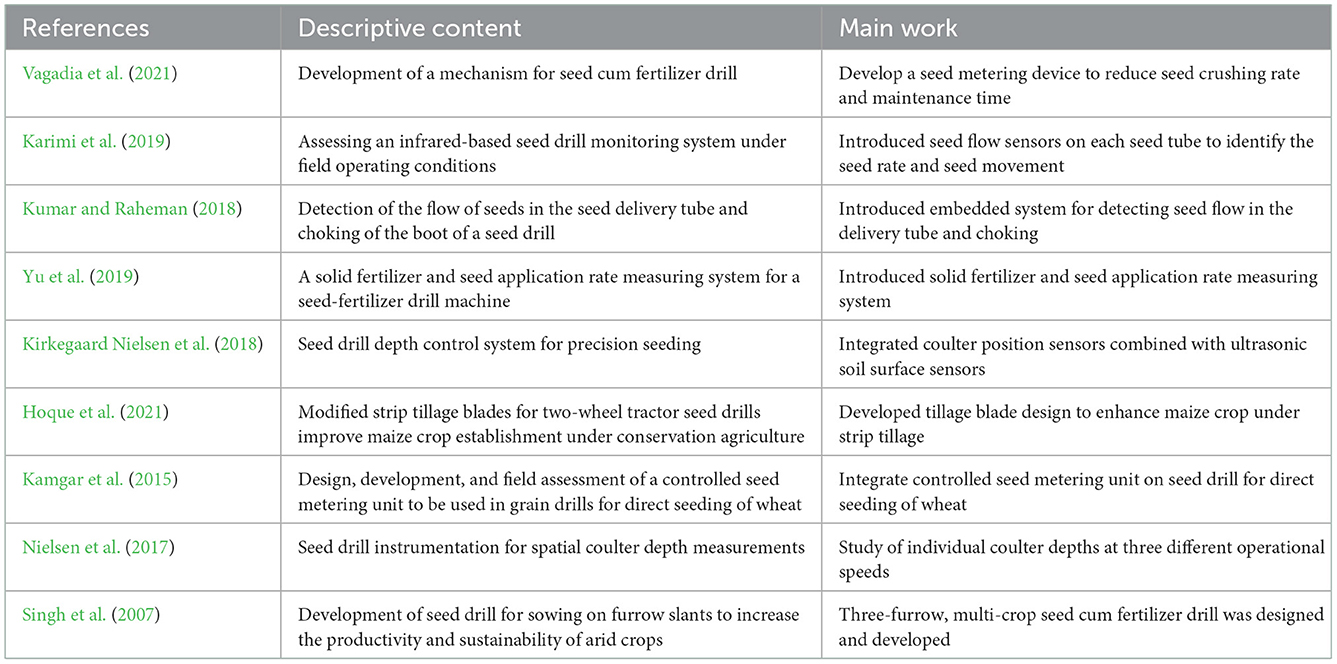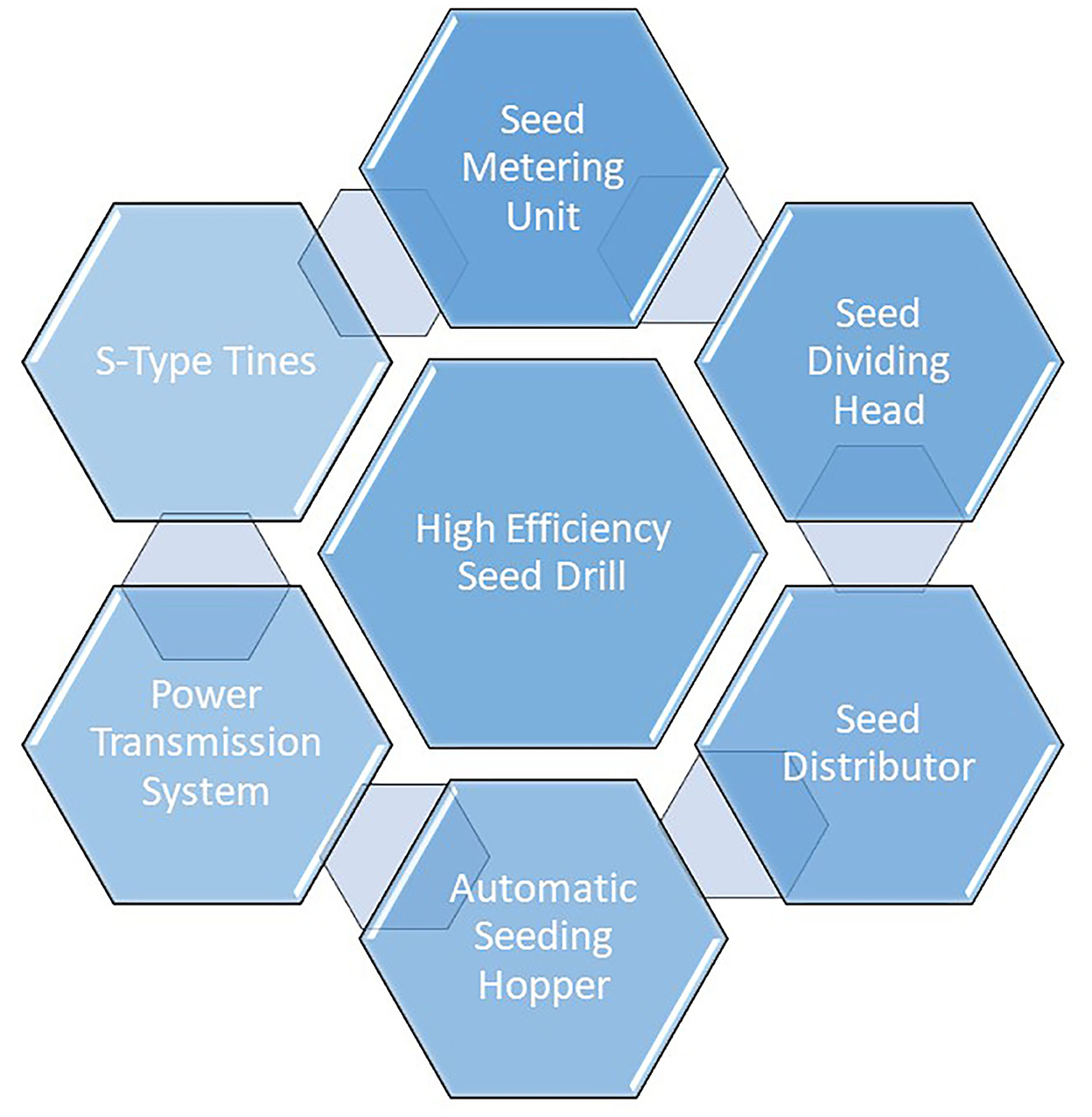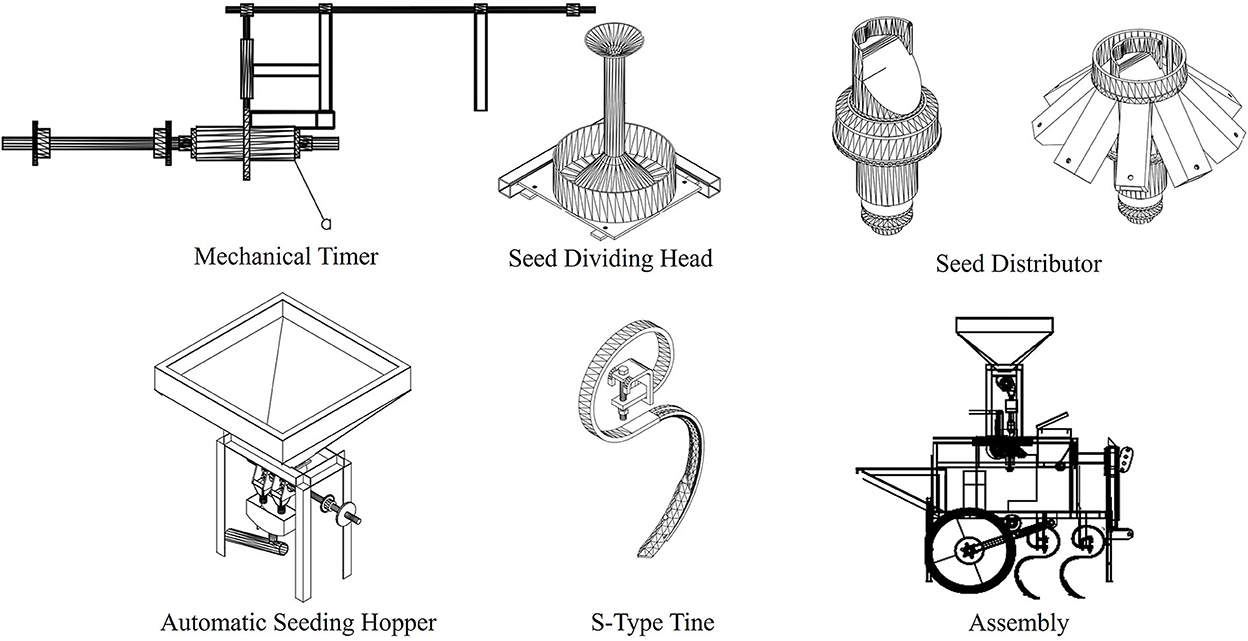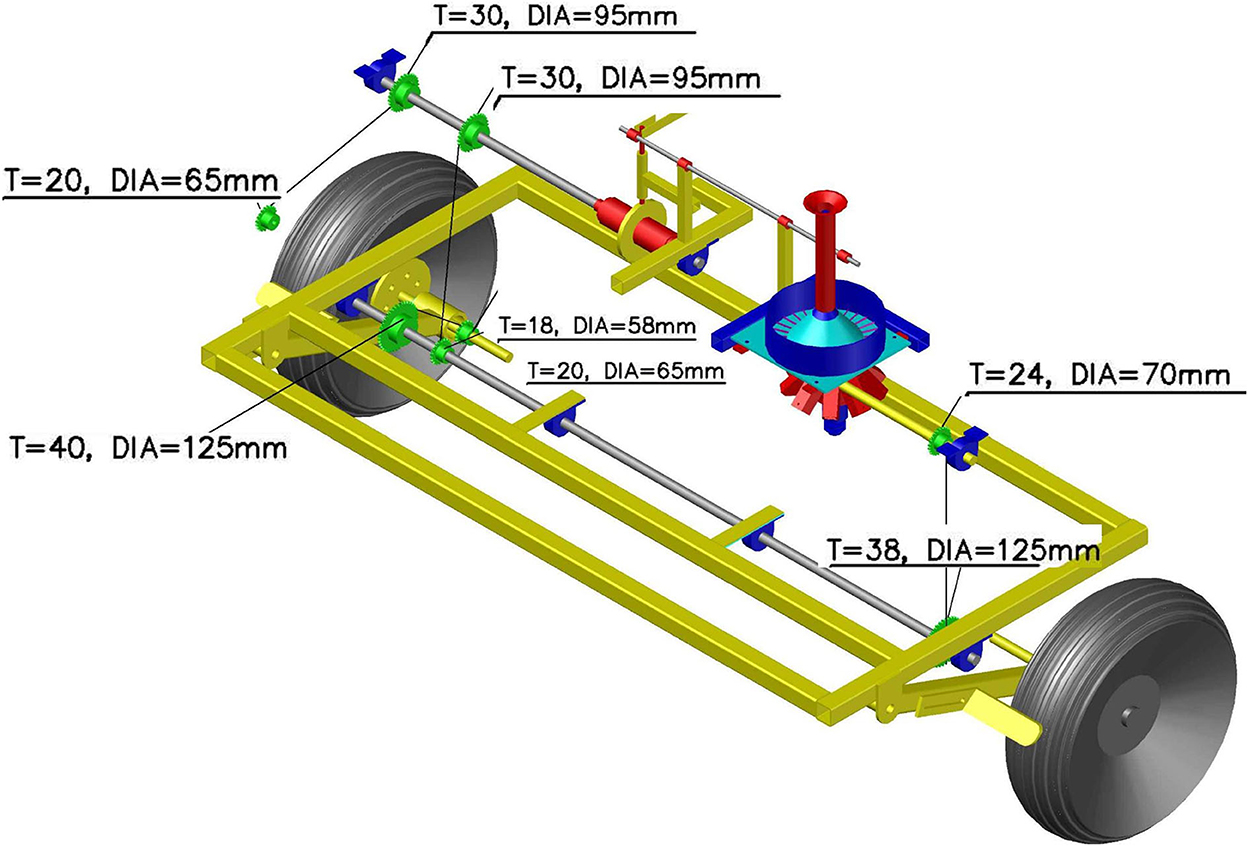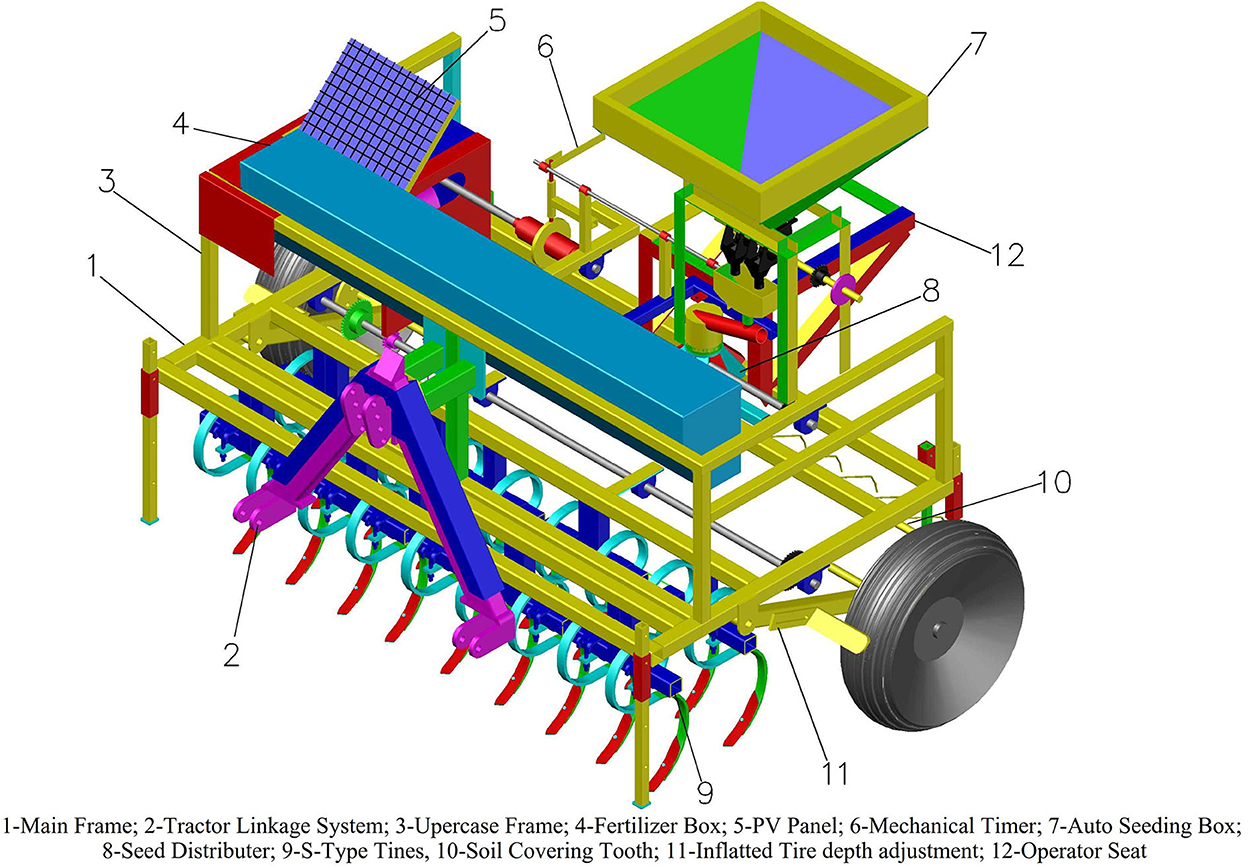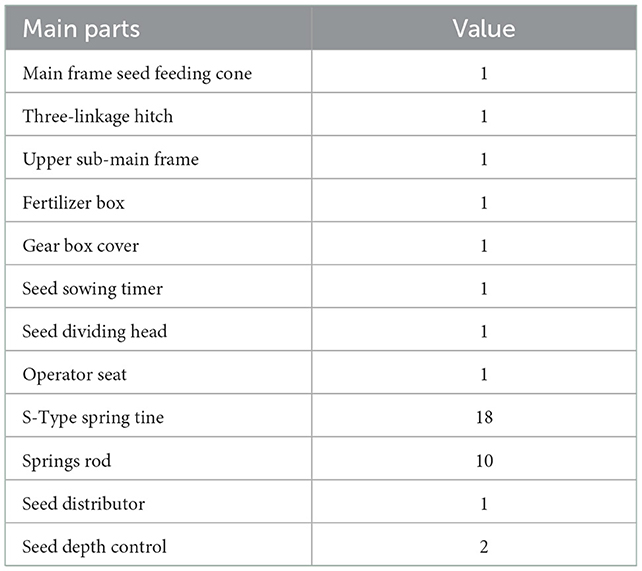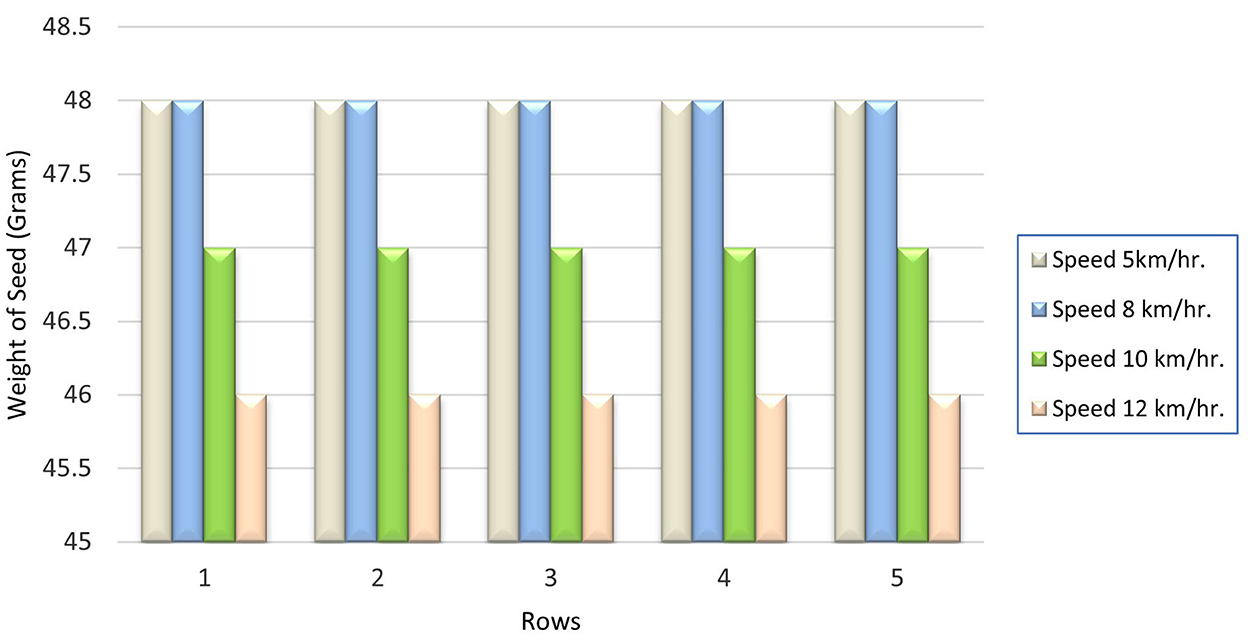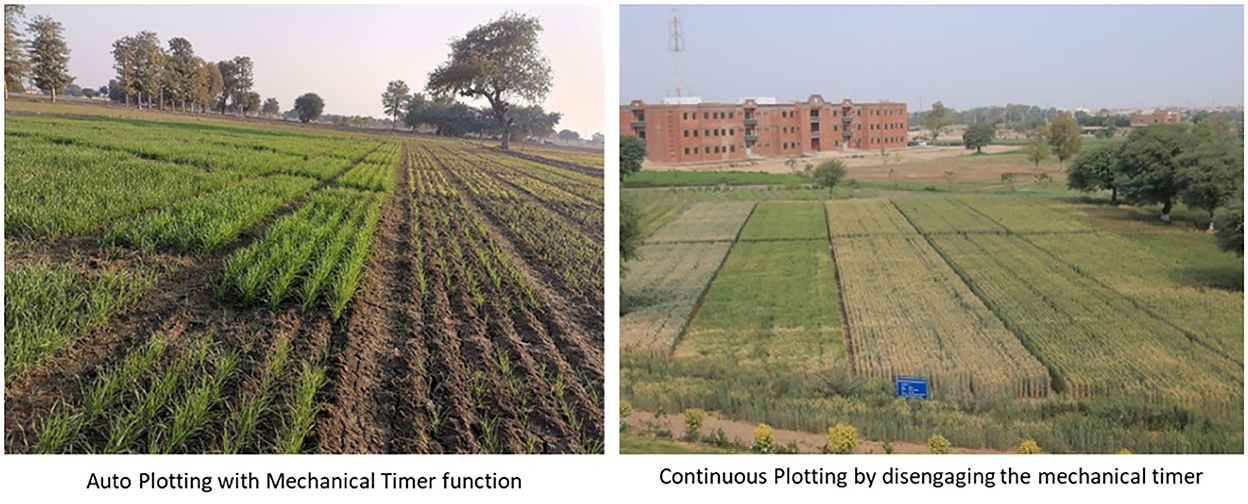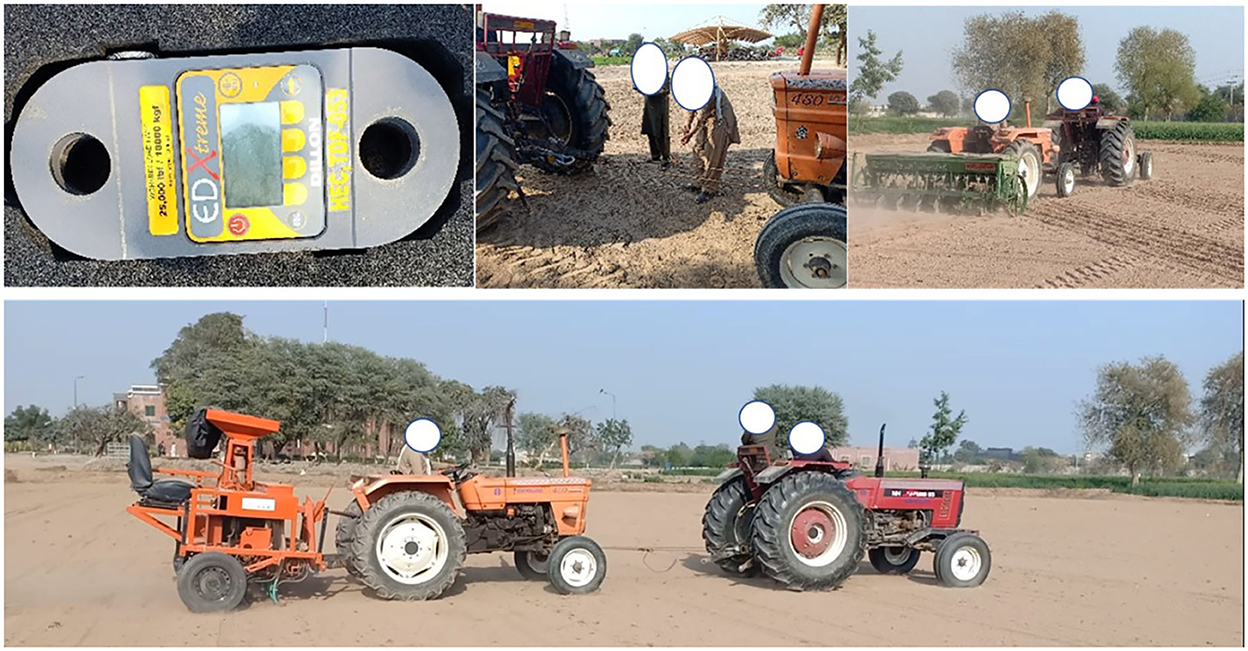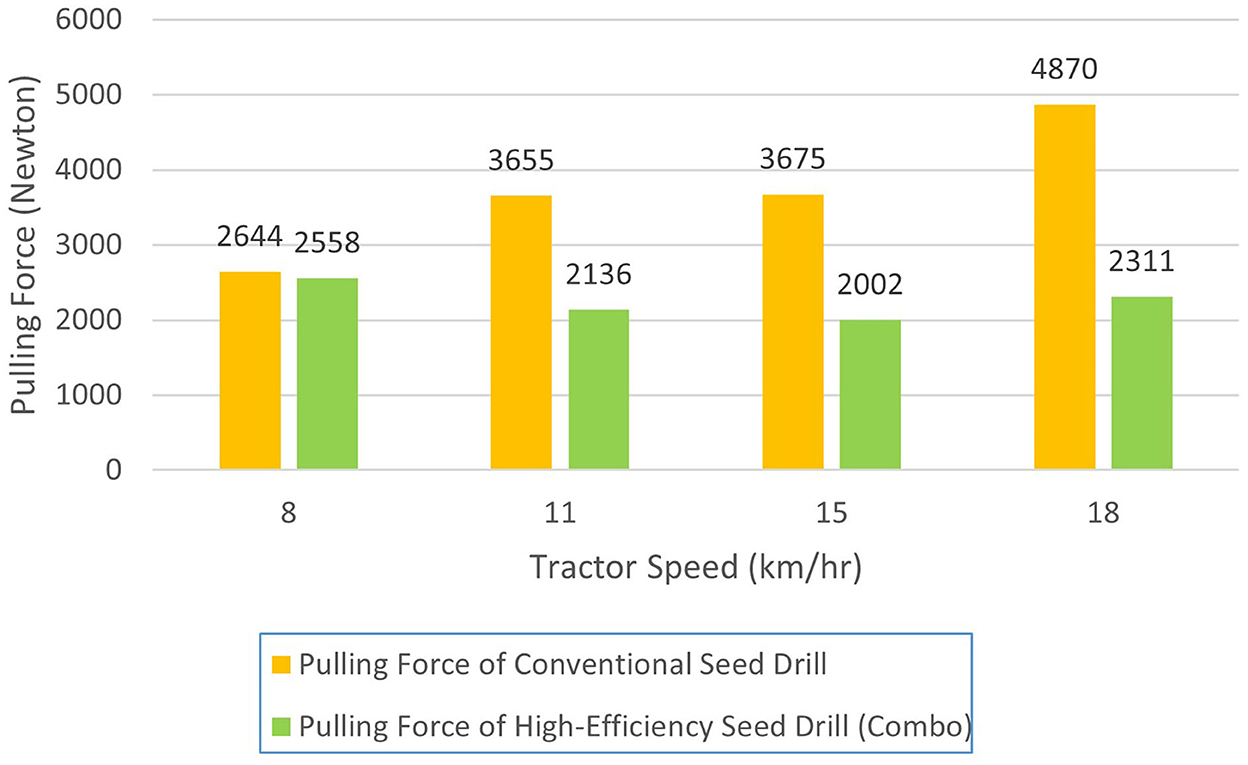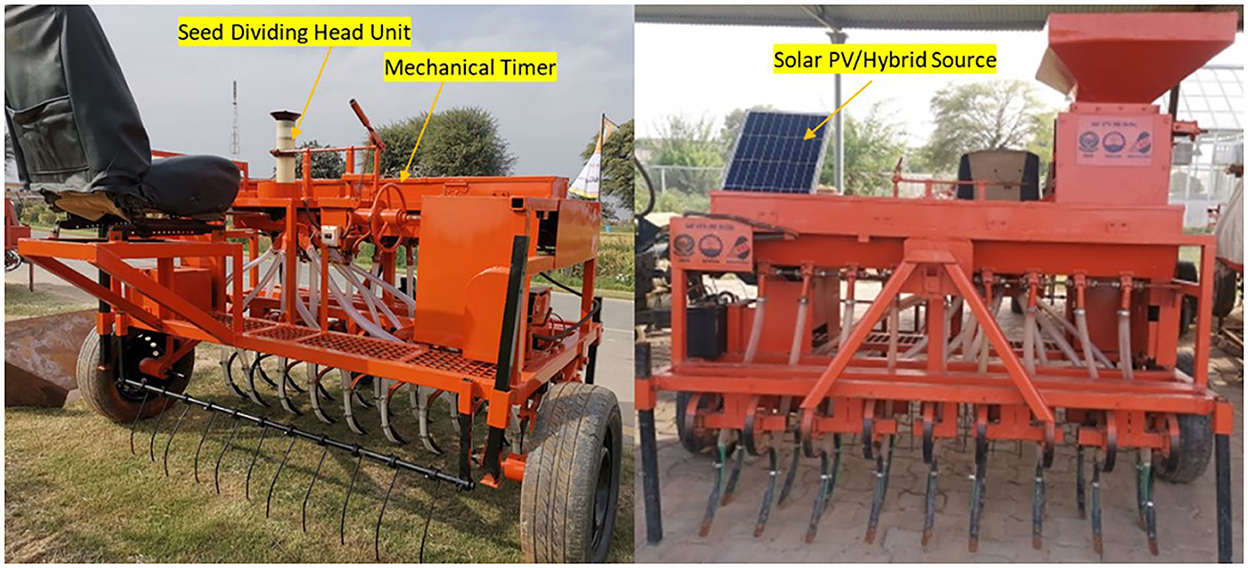- 1Department of Agricultural Engineering, MNS University of Agriculture, Multan, Pakistan
- 2School of Science and Environment, Memorial University of Newfoundland, Corner Brook, NL, Canada
- 3Department of Agricultural and Biosystems Engineering, University of Kassel, Witzenhausen, Germany
- 4Department of Energy Systems Engineering, University of Agriculture, Faisalabad, Pakistan
- 5Department of Biological and Agricultural Engineering, Faculty of Engineering, University Putra Malaysia, Selangor, Malaysia
High crop production with limited energy resources is always the priority area of developing countries. Conventional agricultural experimenting and crop production methods are time-consuming, challenging, laborious, and energy intensive. Various developments and experimental studies have been carried out for advancement in agriculture technologies. This study is mainly focused on the design and development of a unique high-efficiency seed drill machine to increase the energy efficiency of agricultural experiments, and crop production and conserve the tillage, seed, fertilizer, and power requirement. This machine has a special seed dividing head and seed distributor triggered with a mechanical timer. The mechanical timer is responsible to deliver seed to the seed distributor as per fixed plotting intervals. The seed distribution unit distributes the seeds uniformly in all furrows as per the pre-decided seed rate aided with a centrifugal glider aided with a DC motor powered by a 30 W solar PV plate and backup battery. Moreover, the machine has 9 × 9 s-type spring tines for seed and fertilizer, which are mainly designed for better soil pulverization and aeration with significant in-field resource conservation as per conventional alternatives. The effective width is seven feet and adjustable rows with versatile seed rate options. Overall, the results from different field tests verified the uniform seed dispersal with improved germination rate. The analysis of power requirements compared to conventional machines results in the 40% less power requirement. Overall, the machine has customized unique features for experiments and energy-efficient precision agriculture to conserve input resources.
1. Introduction
Agriculture is the backbone of any country which provides food all over the world. Presently, the world situation is becoming more severe due to the COVID pandemic and food security is the main objective in the current scenario. Increasing crop production with energy-efficient technologies is the primary goal of scientists to mitigate the world food requirement (Gorjian et al., 2021). Alternatively, the reduction in input resources is a great challenge for realizing the goal of green development in agriculture and sustainable grain production in the future (Shen et al., 2018). Scaling of agricultural mechanization and the comparative impact is a great initiative to support small landholders (Aguilera et al., 2019; Van Loon et al., 2020). Several agricultural scientists are conducting experiments by using manual, conventional, and very old methods for sowing, harvesting, and post-harvest handling of experimental crops. The improved agricultural mechanization is directly linked to the environment and energy efficiency of any country (Jiang et al., 2020). Manual and conventional methods are time-consuming, challenging, and laborious. Specialized energy-efficient agricultural machines are direly needed for protecting varieties, and precision in sowing, harvesting, and post-harvesting of multiple crops. Among all mentioned operations, precision sowing seed machines are highly demanded by agricultural scientists. Local development of these energy-efficient machines can help in quality research, improve seed production, and crop production, and alleviate food scarcity in the world. To analyze the global impact and importance of the current study the recent developments are presented in Table 1.
Above all studies were carried out to mitigate the inefficiencies in crop cultivation/sowing technologies. Some work about the impact of energy consumption on wheat, paddy, and soybean cultivation was also reported (De et al., 2001; Nassiri and Singh, 2009; Safa et al., 2011). But there is still a huge gap in the study regarding the development of seed metering technology to improve agricultural experimental efficiency. This is also very clear that every step of improvement is the path toward cleaner and energy-efficient production technologies (Todde et al., 2016; Kumar et al., 2021) and precision in agriculture. There are some other studies reported about the need for soil tillage and method as per crop requirement, including the impact of soil tillage and aggregates on crops (Bacenetti et al., 2015; Hu et al., 2021), alternative crop establishing methods (Devkota et al., 2020), and assessment of energy use of different cultivation methods (Kusek et al., 2016). There is not any single version in developed technologies which address all parameters in once i.e., the soil compaction impact on seed germination, low tillage to save energy, seed conservation with precise seed rate, auto plotting for seed breeding trials and the usability for general sowing with single control seed distributing system.
The objective of this research is to design and develop a unique low till high-efficiency seed drill machine with the employment of auto plotting options, adjustable tines, adjustable seed depth, and single point seed control mechanism to make easy control for seed rate adjustment and affordability and acceptance as per multi-crop requirements. Ultimately, the designed version will conserve the wastage of seed and excessive tillage operation without compromising crop production. The conservation in tillage, crop inputs and fuel ultimately also conserve the environment.
2. Materials and methods
The machine design and development were carried out at the Department of Agricultural Engineering, MNS University of Agriculture Multan. The working flow diagram and the drawings of core components are presented in Figures 1, 2. The energy-efficient machine design was completed in several steps by keeping in view the following key objectives:
• Seeding mechanism for auto plotting and general sowing.
• Single-point adjustable seed rate.
• Adjustable seed depth.
• Adjustable row-to-row distance.
• The mechanism for uniform seed dispersal to all furrows.
• Effective machine width as per standard tractor width cover (6–7 ft).
• Low till with better soil aeration/pulverization.
2.1. Seed metering unit
Initially, the mechanism of the different available technologies for seed metering/distribution was studied to develop the indigenized compatible version with auto-plotting options. The mechanical timer concept was taken from the model developed by WINTERSTEIGER (Eskandari and Sartipi, 2016). The developed seed metering system comprised of following parts:
2.2. Seed dividing head
A seed dividing head was designed for low till high-efficiency seed drill. It consists of several channels where the uniform seed is received after the dividend. This channel is synchronized with a mechanical timer. This part is responsible to deliver the seed to a distributor for further transmission and keep the gap between plots as per mechanical timer adjustments.
2.3. Seed distributor
Seed distributor consists of several core components. This distributor has nine openings and one slopy cut shaft. The seed came from the seed dividing head received by this distributor, which is operated by an integrated DC motor. All the seeds are equally distributed to all openings and further furrows guided by the channels.
2.4. Automatic seeding hooper
As the machine also needs to operate for general sowing so an automatic gear flute metering device with a hopper is integrated with the machine as shown in Figure 2. This machine part provides the alternative option for seed dividends with an operator-less facility. The seed rate and flute opening can be adjusted through a single lever adjusted aside from the hopper.
2.5. Power transmission system
The machine operative parts are synchronized with the machine wheel to receive the power train as shown in Figure 3. The shaft and gears were selected as per the required plotting gap. The uniform revolution of seed distributor is very important and to make sure the uniform seed distribution, a 30 W solar PV panel is also fixed with the machine through a maintenance-free battery. It can be seen the PV power is not very high, but it is for the setting of trends and adoptability of alternative energy sources in farm machinery. This power system will also have alternative options to fix with the tractor's already installed battery whichever is convenient for the operator. The backup battery connection will support the motor drive in cloudy weather and minimize the shadow effect while tractor turns.
2.6. S-Type tine
The other major part of the machine after seed metering devices is the seed placement and tillage tool. Figure 2 shows the special s-type low till tines which are primarily used with this machine to make sure the soil aeration and pulverization around the seed.
2.7. High-efficiency seed drill machine
Overall, this machine consists of two rows of 18 adjustable tines, an automatic seed hopper with an alternative seed dividing head, a Solar PV panel, a fertilizer box, and the special linkages system as shown in Figure 4. Each part of the machine has adjustments to make this machine compatible with various crops.
3. Results and discussion
In reference to the RNAM Test Codes and Procedures for Farm Machinery (RNAM and ESCAP, 1995), the machine was formally evaluated concerning the following three categories:
• Uniform seed distribution and wheel slippage effect.
• Comparison of power requirement.
• Field Trials and Comparative analysis.
3.1. Uniform seed distribution and wheel slippage effect
The following is the outline of the test code and procedures:
3.1.1. Definition of terms
A novel high efficiency seed drill.
3.1.2. Specification of high efficiency seed drill
3.1.2.1. Verification of specification
As mentioned in the above specification Table 2 the machine has a unique seed distributor having nine openings on which nine spring tines through PVC pipes. The main objective of this test is to check the equal seed distribution through these nine openings as well as the nine tines of the machine. In this test, the machine was in operational condition at tractor speeds 5, 8, 10, and 12 km/hr. All nine openings were covered with plastic bags to collect the seed during the field operation.
3.1.3. Test condition
Performance of High efficiency Seed Drill varies considerably according to the condition of the field, seed, and operator. Therefore, the condition of the test has to be clearly stated. The range of conditions to be defined is as follows:
• The machine was tested on the same field conditions during all trials.
• The length of the travel was the same (60 m).
• The seed was the same for all trials (Soyabean).
3.1.4. Criteria for evaluation
The main objective of this test is to check the equal seed distribution through these nine openings as well as nine tines of the machine at different speeds of the tractor.
Before starting the test of the seed drill machine in the laboratory, the number of revolutions of the wheel for 1/100 hectare was determined using the following Equation (1) (Karim et al., 2015):
where N = number of revolutions of the wheel; x = row spacing in meters; n = number of rows of the seeder; d = diameter of the wheel in meters.
The seed rate was determined using the following Equation (2):
where, C = Seed rate, kg ha−1; A = Weight of seed collected during N turns of the wheel, kg; D = Diameter of the wheel, W = Width of the drill.
3.1.5. Speed test
The significance and the sustainability of the machine's seed distribution system are shown in Figure 5. It revealed that the machine is distributing the uniform seed into all rows. Moreover, as the speed is higher than 8 km/hr, the seed rate is reduced. It is maybe due to the slippage of the driving wheels of the machine.
The seed distribution was uniform through all row channels and at all tractor speeds. The slippage effect increased when the speed rises from 10–12 km/hr. The optimal speed for this machine is recommended from 5 to 10 km/hr, above this speed, a slippage factor (2–3%) should be considered during seed rate adjustments. The slippage effect is also related with soil conditions. In conventional seed drills there is an independent seed metering flutes on each tube/furrow. There is always a challenge to calibrate and disburse the seed uniformly through all seed metering flutes. The high efficiency seed drill has the advantage because of single point seed distribution mechanism which reduces the chance of variability in seed rate of each furrow and reduces the excessive calibration efforts.
The auto plotting function of the machine with and without the employment of mechanical timer was also experimented as shown in Figure 6. In auto plotting option, the seed uniformly distributed on seed dividing head. The seed is further dropped on seed distributer from each channel of the seed dividing head. After three revolution of drive wheel, head unit complete its one cycle of seed dropping on seed distributor. In one cycle of the dividing head machine covered the distance of six meter in linear length. The head unit still in closing position up to a more half revolution of drive wheel to maintain the one-meter gap (without seed dispersal). In general sowing, the head unit is disengaged and the continuous seed supply through seed hopper is engaged. The machine has the potential of auto plotting (6 meter in length with one meter gap) for efficient agricultural seed experiments and long strip plots for general sowing.
3.2. Comparison of power requirement
Tractor and implement matching concerns the proper balancing of the load characteristics of an implement with the output characteristics of a tractor to achieve the most effective working with the least fuel consumption. An experiment was performed to compare the pulling force (N) to drag High-Efficiency Seed Drill and a conventional seed drill in the same soil and operating condition.
Both machines were operated by a tractor with a draft dynamometer (Load Range: 25,000 lbf/10,000 kgf; Accuracy: within ± 0.1% F.S.) to check the pulling draft as shown in Figure 7. The Draft dynamometer used in this study has the two-linkage provision. It was not possible to connect the seed drill machine directly through the draft dynamometer that's why two tractors were used for the experiment. In the first case, two tractors connected through the draft dynamometer, and the pulling force was measured for the 2nd tractor. In 2nd case, the first tractor is connected to 2nd tractor through a dynamometer and the machine is mounted with 2nd tractor. The 2nd tractor is just used as an idler (neutral) without any pulling force in the whole experiment. In the end, the pulling force specifically for the machine was calculated after minimizing the pulling force measured in the first case.
Both machines were operated at various tractor speeds from 8, 11, 15, and 18 km/hr, and the pulling force was recorded accordingly as presented in Figure 8. The measured force for conventional drill varies from 2.6 kN to 4.8 kN and the high efficiency seed drill ranges between 2.0 kN to 2.5 kN. It is observed that the power requirement of high efficiency seed drill is almost half (more than 40% saving) as compared to the conventional drill. It is because the high efficiency seed drill faces the least soil resistance due to the inflated tires and low till shock absorbing S-type tines and alleviates the excessive load and fuel consumption.
3.3. Solar PV/hybrid seed metering mechanism
The high-efficiency seed drill is developed in three phases. In the first phase, the dies and fixtures for the fabrication of the seed dividing head and distributor were modeled. In the second phase, the machine with seed dividing head, seed distributor, and the mechanical timer was fabricated followed by field testing for experimental plotting (Figure 9). In this version only the metering system with a seed-dividing head was functioned. There must an operator is required to pore the seed as per the required seed rate (measured volume) or the different seed varieties for plotting different seed trials. Whereas in third phase of development the machine is integrated with seed hopper, provision of solar PV/hybrid power source which enabled the option of operator less drilling of seed. The seed rate can be adjusted with single point adjusting unit as per marked scale. Both metering systems can work alternatively as the seed delivery channels are the same. The calculated and evaluated field capacity of the machine was 20 min/acre (@10 km/h speed of the tractor).
Multiple field testing but not limited to wheat, cotton, mungbean, soybean, chickpea, canola, and maize were carried out to evaluate the machine versatility for multi-crop sowing options. It was revealed that the machine seed dividing head system can sow a variety of seeds for experimental as well as general sowing. The machine was tested on multiple crops and categorically provision of sowing all crops seed ranges from canola seed size to chickpea seed size.
4. Conclusion
A low till High-efficiency Seed Drill for multi-crop applications was developed. The machine has significant advantages with the provision of auto plotting for seed experiments, single-point adjustable seed rate (5–60 kg), adjustable seed depth, adjustable row-to-row spacing, a unique seed distribution/metering mechanism, and employment of s-type tines to make the machine more effective with low till better soil aeration. This machine is highly beneficial to restrict the wastage of seed with precise placement, higher germination rate, timely experimental plotting, and multi-crop applications. Moreover, the seed rate is very consistent and uniform up to the speed of 8 km/hr. The wheel slippage factor should be added to the required seed rate when operating at higher tractor speeds. This machine would be a good choice among stakeholders because of its versatile adjustment options as per crop requirements. The one constraint should be considered for good results which is the proper preparation of the field. As this is not zero till machine, so it requires optimum tillage practices and residue management of the previous crop. The machine has very sophisticated tines which can broke due to improper field management.
Data availability statement
The raw data supporting the conclusions of this article will be made available by the authors, without undue reservation.
Author contributions
US, SH, and AK contributed to conception and design of the study. US, SH, and MZ conducted the field trials analysis the data. US, SH, and NH wrote the first draft of the manuscript. AK, NH, and MZ wrote sections of the manuscript. All authors contributed to manuscript revision, read, and approved the submitted version.
Funding
This work was funded by the University of Agriculture Faisalabad, Endowment Fund Secretariat (UAF-EFS RD-035/20), National Research Program for Universities by Higher Education Commission (NRPU-16821), our collaborators from University of Sydney, and the University of Kassel, Germany.
Conflict of interest
The authors declare that the research was conducted in the absence of any commercial or financial relationships that could be construed as a potential conflict of interest.
Publisher's note
All claims expressed in this article are solely those of the authors and do not necessarily represent those of their affiliated organizations, or those of the publisher, the editors and the reviewers. Any product that may be evaluated in this article, or claim that may be made by its manufacturer, is not guaranteed or endorsed by the publisher.
References
Aguilera, E., Guzmán, G. I., de Molina, M. G., Soto, D., and Infante-Amate, J. (2019). From animals to machines. The impact of mechanization on the carbon footprint of traction in Spanish agriculture: 1900–2014. J. Clean. Prod. 221, 295–305. doi: 10.1016/j.jclepro.2019.02.247
Bacenetti, J., Fusi, A., Negri, M., and Fiala, M. (2015). Impact of cropping system and soil tillage on environmental performance of cereal silage productions. J. Clean. Prod. 86, 49–59. doi: 10.1016/j.jclepro.2014.08.052
De, D., Singh, R. S., and Chandra, H. (2001). Technological impact on energy consumption in rainfed soybean cultivation in Madhya Pradesh. Appl. Energy 70, 193–213. doi: 10.1016/S0306-2619(01)00035-6
Devkota, K. P., Khanda, C. M., Beebout, S. J., Mohapatra, B. K., Singleton, G. R., and Puskur, R. (2020). Assessing alternative crop establishment methods with a sustainability lens in rice production systems of Eastern India. J. Clean. Prod. 244, 118835. doi: 10.1016/j.jclepro.2019.118835
Eskandari, I., and Sartipi, N. (2016). Construction of an experimental plot seeder of wheat planting and compare it by imported one. J. Agric. Mach. 6, 298–311.
Gorjian, S., Ebadi, H., Trommsdorff, M., Sharon, H., Demant, M., Schindele, S., et al. (2021). The advent of modern solar-powered electric agricultural machinery: A solution for sustainable farm operations. J. Clean. Prod. 292, 126030. doi: 10.1016/j.jclepro.2021.126030
Hoque, M. A., Gathala, M. K., Hossain, M. M., Ziauddin, A. T. M., and Krupnik, T. J. (2021). Modified strip tillage blades for two-wheel tractor seed drills improves maize crop establishment under conservation agriculture. Dev. Eng. 6, 100061. doi: 10.1016/j.deveng.2021.100061
Hu, R., Liu, Y., Chen, T., Zheng, Z., Peng, G., Zou, Y., et al. (2021). Responses of soil aggregates, organic carbon, and crop yield to short-term intermittent deep tillage in Southern China. J. Clean. Prod. 298, 126767. doi: 10.1016/j.jclepro.2021.126767
Jiang, M., Hu, X., Chunga, J., Lin, Z., and Fei, R. (2020). Does the popularization of agricultural mechanization improve energy-environment performance in China's agricultural sector? J. Clean. Prod. 276, 124210. doi: 10.1016/j.jclepro.2020.124210
Kamgar, S., Noei-Khodabadi, F., and Shafaei, S. M. (2015). Design, development and field assessment of a controlled seed metering unit to be used in grain drills for direct seeding of wheat. Inf. Process. Agric. 2, 169–176. doi: 10.1016/j.inpa.2015.08.001
Karim, M. F., Alam, M., Ali, M. R., and Kozan, O. (2015). Design and development of a drum seeder with urea supergranule application for rural farmers in Bangladesh. Int. Agric. Eng. J. 17, 61–71.
Karimi, H., Navid, H., Besharati, B., and Eskandari, I. (2019). Assessing an infrared-based seed drill monitoring system under field operating conditions. Comput. Electron. Agric. 162, 543–551. doi: 10.1016/j.compag.2019.04.045
Kirkegaard Nielsen, S., Munkholm, L. J., Lamandé, M., Nørremark, M., Edwards, G. T. C., Green, O., et al. (2018). Seed drill depth control system for precision seeding. Comput. Electron. Agric. 144, 174–180. doi: 10.1016/j.compag.2017.12.008
Kumar, R., and Raheman, H. (2018). Detection of flow of seeds in the seed delivery tube and choking of boot of a seed drill. Comput. Electron. Agric. 153, 266–277. doi: 10.1016/j.compag.2018.08.035
Kumar, R., Sarkar, B., Bhatt, B. P., Mali, S. S., Mondal, S., Mishra, J. S., et al. (2021). Comparative assessment of energy flow, carbon auditing and eco-efficiency of diverse tillage systems for cleaner and sustainable crop production in eastern India. J. Clean. Prod. 293, 126162. doi: 10.1016/j.jclepro.2021.126162
Kusek, G., Ozturk, H. H., and Akdemir, S. (2016). An assessment of energy use of different cultivation methods for sustainable rapeseed production. J. Clean. Prod. 112, 2772–2783. doi: 10.1016/j.jclepro.2015.10.015
Nassiri, S. M., and Singh, S. (2009). Study on energy use efficiency for paddy crop using data envelopment analysis (DEA) technique. Appl. Energy 86, 1320–1325. doi: 10.1016/j.apenergy.2008.10.007
Nielsen, S., Munkholm, S. K., Lamandé, L. J., Nørremark, M., Skou-Nielsen, M., Edwards, N., et al. (2017). Seed drill instrumentation for spatial coulter depth measurements. Comput. Electron. Agric. 141, 207–214. doi: 10.1016/j.compag.2017.07.014
RNAM and ESCAP. (1995). RNAM Test Codes and Procedures for Farm Machinery. Bangkok: RNAM technical publications.
Safa, M., Samarasingh, S., and Mohssen, M. (2011). A field study of energy consumption in wheat production in Canterbury,New Zealand. Energy Convers. Manag. 52, 2526–2532. doi: 10.1016/j.enconman.2011.01.004
Shen, J., Zhang, F., and Siddique, K. H. M. (2018). Sustainable resource use in enhancing agricultural development in China. Engineering 4, 588–589. doi: 10.1016/j.eng.2018.08.007
Singh, H., Kushwaha, H. L., and Mishra, D. (2007). Development of seed drill for sowing on furrow slants to increase the productivity and sustainability of arid crops. Biosyst. Eng. 98, 176–184. doi: 10.1016/j.biosystemseng.2007.07.009
Todde, G., Murgia, L., Caria, M., and Pazzona, A. (2016). A multivariate statistical analysis approach to characterize mechanization, structural and energy profile in Italian dairy farms. Energy Rep. 2, 129–134. doi: 10.1016/j.egyr.2016.05.006
Vagadia, R., Kadegiya, H., Desai, P., Gautam, A., and Chaudhary, H. (2021). Development of a mechanism for seed cum fertilizer drill. Materials Today. 47, 3210–3216. doi: 10.1016/j.matpr.2021.06.331
Van Loon, J., Woltering, L., Krupnik, T. J., Baudron, F., Boa, M., Govaerts, B., et al. (2020). Scaling agricultural mechanization services in smallholder farming systems: Case studies from sub-Saharan Africa, South Asia, and Latin America. Agric. Syst. 180, 102792. doi: 10.1016/j.agsy.2020.102792
Keywords: agricultural engineering, farm mechanization, resource conservation, precision agriculture, advanced seeding technology
Citation: Sultan U, Khan AA, Husnain SN, Zohaib M and Hashim N (2023) Multi crop high efficiency seed drill with solar hybrid seed metering: A step toward precision and sustainability. Front. Sustain. Food Syst. 6:1081122. doi: 10.3389/fsufs.2022.1081122
Received: 26 October 2022; Accepted: 23 December 2022;
Published: 11 January 2023.
Edited by:
Aditya Parmar, University of Greenwich, United KingdomCopyright © 2023 Sultan, Khan, Husnain, Zohaib and Hashim. This is an open-access article distributed under the terms of the Creative Commons Attribution License (CC BY). The use, distribution or reproduction in other forums is permitted, provided the original author(s) and the copyright owner(s) are credited and that the original publication in this journal is cited, in accordance with accepted academic practice. No use, distribution or reproduction is permitted which does not comply with these terms.
*Correspondence: Umair Sultan,  dW1haXIuc3VsdGFuQG1uc3VhbS5lZHUucGs=; Syed Nabeel Husnain,
dW1haXIuc3VsdGFuQG1uc3VhbS5lZHUucGs=; Syed Nabeel Husnain,  bmFiZWVsLmh1c25haW5AdW5pLWthc3NlbC5kZQ==;
bmFiZWVsLmh1c25haW5AdW5pLWthc3NlbC5kZQ==;  bmFiZWVsLmh1c25haW5AdWFmLmVkdS5waw==
bmFiZWVsLmh1c25haW5AdWFmLmVkdS5waw==
 Umair Sultan
Umair Sultan Alamgir Akhtar Khan
Alamgir Akhtar Khan Syed Nabeel Husnain
Syed Nabeel Husnain Muhammad Zohaib1
Muhammad Zohaib1 Norhashila Hashim
Norhashila Hashim